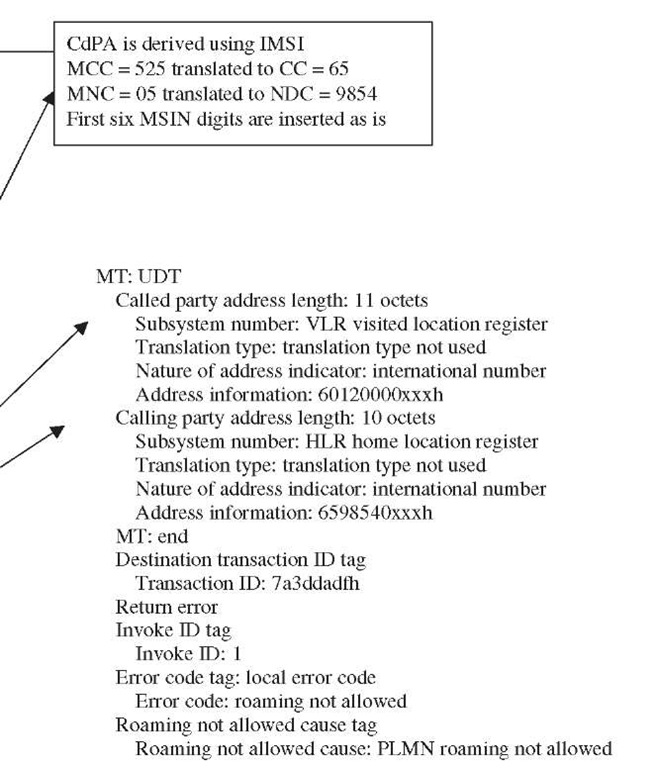This section describes the information transfer and procedures that take place between the VPLMN and the HPLMN to enable roaming. On first-time roamer registration in a VPLMN, the serving VLR updates the HPLMN HLR with the new location of the MS (i.e., the VLR address), using the update location procedure. The HLR uses the cancel location procedure with the first VPLMN when a roamer appears in a different PLMN or returns to the HPLMN. The VPLMN VLR invokes the subscriber parameter request procedure (at any time) to request the HLR to provide subscriber parameters for a specified roamer. A VLR may use the purge procedure to inform the HLR of the deletion of data for a roamer that has not established radio contact for a specified period. On restart of the HLR after a failure, recovery and restore procedures are invoked by the HLR.
Location update in a visited network
The update location procedure is initiated by the VPLMN VLR when –
■ A roamer turns ON an MS for the first time in a foreign network, i.e., to attach/register.
■ A roamer moves to a new location area (LA), i.e., forced registration.
■ The VLR receives instructions as a consequence of an HLR or a VLR restoration.
Figure 6-7 MGT translation.
The VLR also initiates the update location procedure periodically to ensure that mobiles are not detached accidentally from the system.
The map update procedure is used by the VPLMN VLR to update the location information stored in the HPLMN HLR. Figure 6-8 illustrates the location update procedure. The following information fields/parameters are sent from the serving MSC/VLR in the visited network to the HLR in the roamer’s home country.
■ IMSI
■ MSC address
■ VLR number
The HPLMN HLR uses IMSI as the key to extract the roamer’s information from its database. The MSC address is the E.164 address of the serving MSC. The HLR stores the serving MSC address (i.e., the current location of the roamer) in its database. The VLR number is the E.164 ISDN number of the VLR. The HPLMN HLR uses the MSC address and the VLR number in subsequent roaming procedures and call handling.
Figure 6-9 shows the protocol decodes for a MAP update location request message invoked by a serving VLR in a visited network.
As part of the location update procedure, the HPLMN HLR sends the subscriber parameters of the roamer to the VPLMN VLR. The HPLMN HLR invokes the MAP insert subscriber data procedure to update the VPLMN VLR.
Figure 6-8 Update location procedure.
Figure 6-9 Example message decodes for an update location request.
The important parameters sent by the HLR are as follows –
■ MSISDN. The ISDN number assigned to the roamer.
■ IMSI. The IMSI of the roamer.
■ Category. This refers to the calling party category. It is included either at location updating or when it is changed.
■ Subscriber status. This parameter is set to service granted if no operator-determined barring (ODB) is required. To apply, remove, or update ODB, the subscriber status is set to operator-determined barring. In this case, the ODB parameter is present.
■ Forwarding information list. This includes the SS code for an individual call forwarding supplementary service.
■ Call barring information list. This includes the SS code for an individual call barring supplementary service.
■ CUG information list. This includes the complete subscribed CUG feature list.
■ Bearer service list. This lists the codes of all bearer services subscribed to by the roamer.
■ Teleservice list. This lists the codes of all the teleservices subscribed to by the roamer.
■ Operator-determined barring HPLMN data. This includes all the operator-determined barring categories that may be applied to a roamer in a VPLMN.
■ SS code list. This lists the SS codes for individually subscribed supplementary services. It is sent for supplementary services other than call forwarding, call barring, and CUG.
Figure 6-10 shows a partial decode of a MAP insert subscriber data operation code.
In the case of unsuccessful updating, the HPLMN HLR responds with an error message. An error cause is included to inform VPLMN VLR of the reason for failure.
In the event of failures, several different error causes can be returned:
■ Unknown subscriber. No such subscriber.
■ Roaming not allowed. The diagnostic code provides further information.
■ PLMN not allowed
■ Operator-determined barring
Figure 6-10 Example message decode for insert subscriber data.
PLMN not allowed is used as the default if no qualifying information is received.
■ Unexpected data value. The data type is formally correct but its value or presence is unexpected in the current context.
■ System failure. The task cannot be performed because of a problem in the other node. The type of node or network resource may be indicated by use of the network resource parameter.
■ Data missing. An optional parameter required by the context is missing.
Figure 6-11 shows an HPLMN HLR responding with an error stating that this subscriber is not allowed to roam in a foreign network.





